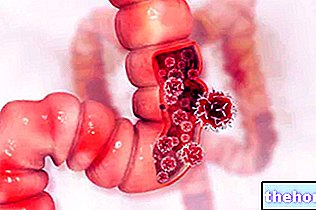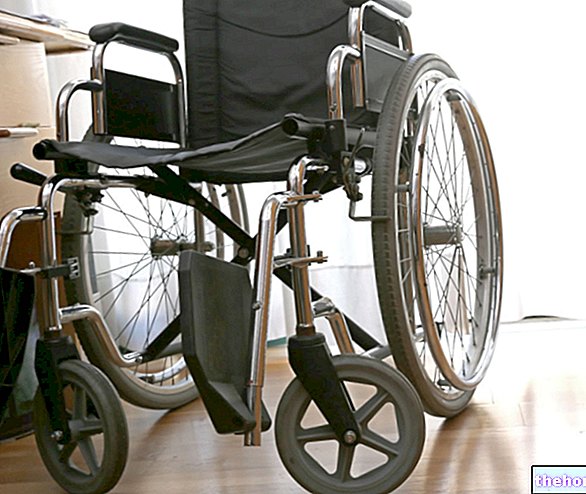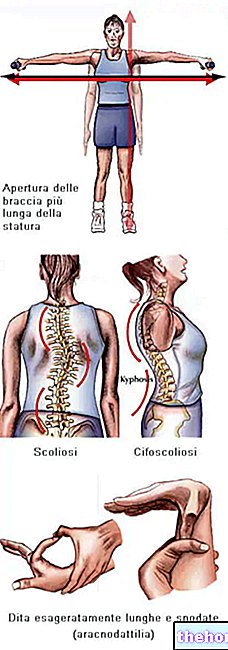
Due to the mutation of one of the genes known with the abbreviations TCOF1, POLR1C and POLR1D, Treacher Collins syndrome can be both a condition acquired during embryonic development and a hereditary condition.
The symptoms and signs of Treacher Collins syndrome can be seen, in part, already at birth, which favors early diagnosis.
Currently, unfortunately, those suffering from Treacher Collins syndrome can only count on symptomatic treatments - that is, aimed at relieving the symptoms - as there is no cure capable of canceling the consequences of the mutation affecting the 3 aforementioned genes.
Epidemiology
According to statistics, one in every 50,000 individuals is born with Treacher Collins syndrome.
Treacher Collins syndrome is therefore included in the list of so-called rare genetic diseases.
Origin of the name
Treacher Collins syndrome owes its name to Edward Treacher Collins, the English surgeon and ophthalmologist who, around 1900, described it for the first time in detail and in depth.
) of one of the human genes known with the abbreviations TCOF1, POLR1C and POLR1D.In other words, an individual suffers from Treacher Collins syndrome when one of the TCOF1, POLR1C and POLR1D genes exhibits a "DNA sequence abnormality."
Genes implicated in Treacher Collins syndrome: location and normal function
Premise: the genes present on human chromosomes are DNA sequences that have the task of producing fundamental proteins in biological processes essential to life, including cell growth and replication.
The TCOF1, POLR1C and POLR1D genes reside on chromosome 5, chromosome 6 and chromosome 13, respectively.
In the absence of mutations affecting them (when in a person not affected by Treacher Collins syndrome), the aforementioned genes each produce a protein with a key role in the correct development of the bones and soft tissues of the face; more specifically, they produce proteins responsible for the production of ribosomal RNA (a particular type of RNA), which serves to regulate the growth processes of the bones and soft tissues of the face.

What causes the genes associated with Treacher Collins syndrome to mutate?
In the presence of the mutations responsible for Treacher Collins syndrome, the TCOF1, POLR1C and POLR1D genes lose the ability to express functional proteins, which leads to the absence of guiding elements during the developmental processes of the bones and soft tissues of the face.
In other words, the genetic mutations at the origin of Treacher Collins syndrome cause the absence of agents responsible for regulating the correct growth of the bone and soft tissues constituting the human face.
Hereditary or acquired disease?
Treacher Collins syndrome can be the result of both a hereditary mutation (i.e. transmitted by parental route) and a mutation acquired spontaneously, out of nowhere and without precise reasons, during the course of embryonic development (i.e. after the sperm has fertilized the egg and embryogenesis began).
Statistically, Treacher Collins syndrome is more frequently an acquired condition than an inherited condition; in fact, it is related to an acquired type mutation, in 60% of clinical cases, and to a hereditary type mutation, in the remaining 40% (*)
* Please note: the statistical data in question relate exclusively to cases of Treacher Collins syndrome due to the mutation of the TCOF1 and POLR1D genes.
For clinical cases associated with the POLR1C gene mutation, there is no information on the type of mutation.
Inheritance in Treacher Collins syndrome
To understand…
- Each human gene is present in two copies, called alleles, one of maternal origin and one of paternal origin.
- A genetic disease is autosomal dominant when the mutation of a single copy of the gene that causes it is sufficient to manifest itself.
- An inherited disease is autosomal recessive when both copies of the gene that causes it must mutate to occur.
Treacher Collins syndrome due to the mutation of the TCOF1 and POLR1D genes has all the characteristics of an autosomal dominant disease; on the other hand, Treacher Collins syndrome related to the POLR1C gene mutation has the genetic characteristics typical of an autosomal recessive disease.
small and small chin (together, these two anomalies constitute the so-called micrognathy);- Poorly developed cheekbones;
- Ocular anomalies of various kinds, including:
- Eyes directed downwards;
- Coloboma of the lower eyelid (partial or total absence of the skin tissue constituting the lower eyelid);
- Upper and lower eyelid ptosis;
- Unusual narrowing of the tear ducts
- Absence of eyelashes on the lower eyelid.
- Missing ears, small or deformed, and abnormal development of the ear canal;
Other possible symptoms
Sometimes, Treacher Collins syndrome can further enrich the classic picture of symptoms and signs reported above by causing:
- Brachycephaly;
- Dental deformities, such as:
- Dental agenesis (lack of one or more teeth);
- Dull enamel teeth;
- Bad positioning of the maxillary first molars;
- Teeth too far apart (dental diastema).
- Macrostomy (abnormal enlargement of the mouth opening);
- Cleft palate;
- Ocular hypertelorism (eyes that are too far apart);
- Heart defects;
- Nasal deformities;
- Unusual hairline at the level of the ears.
What happens in the most serious cases?
When Treacher Collins syndrome is particularly severe, it happens that:
- Defects in the cheekbones, jaw and chin, and dental deformities are so severe that they induce respiratory problems, dental malocclusion and chewing disorders;
- The anomalies at the level of the ears are so deep that they cause hearing deficits and, consequently, speech problems;
- Nasal deformities are so marked that the patient suffers from choanal atresia and sleep apnea syndrome, and develops further respiratory problems;
- The ocular anomalies are so pronounced that the patient suffers from a loss of vision (due to refractive defects), strabismus and anisometropia (it is when the eyes have a different refraction).
Does Treacher Collins Syndrome Impair Intelligence?
Usually, Treacher Collins syndrome has no effect on the intellectual development of the person it affects; in other words, those who suffer from Treacher Collins syndrome generally have "normal intelligence."
Did you know that ...
According to statistics, Treacher Collins syndrome is associated with intellectual problems in a small 5% of clinical cases (therefore, in 95% of cases it is related to "completely normal intelligence).
Complications on a psychological level
Due to the facial deformities with which he is destined to live, the sufferer of Treacher Collins syndrome tends to develop psychological problems (depression, low mood, social phobia, etc.), especially during adolescence and at a more mature age. they compromise the insertion in a social context and, more generally, the whole quality of life.
;Sometimes, these evaluations are followed by a series of radiological examinations (eg CT and X-rays) with the aim of further enriching the picture of the clinical data collected previously.
Medical history and physical examination
Anamnesis and physical examination essentially consist in an accurate evaluation of the symptoms exhibited by the patient.
In the context of Treacher Collins syndrome, it is in these phases of the diagnostic process that the doctor ascertains the presence of various facial anomalies and any related problems (respiratory disorders, chewing disorders, dental malocclusion, visual anomalies, etc.) .
Genetic test
It is the DNA analysis aimed at detecting mutations in critical genes.
In a context of Treacher Collins syndrome, it represents the confirmatory diagnostic test, as it allows to highlight the mutation of one of TCOF1, POLR1C and POLR1D.
Radiological examinations
In a context of Treacher Collins syndrome, radiological examinations may have, as an object of interest, the dental structure and the anatomy of the auditory canal.
Their realization is indicated, above all, when the present genetic condition has caused severe deformations of the teeth and / or severe hearing deficits. The images, in fact, coming from a CT scan of the auditory canal or X-rays of the dental arches are of enormous help when planning a therapy against the aforementioned dental deformations and the aforementioned hearing deficits.
When is the diagnosis made? Is an antenatal diagnosis possible?
Treacher Collins syndrome is diagnosable from the very first moments of life. Clearly, such an early diagnosis is easier for an experienced physician or when there is a suspicion that the unborn child may be a carrier of the condition in question.

PRENATAL DIAGNOSIS
The prenatal diagnosis of Treacher Collins syndrome is possible only through a prenatal genetic test, performed on a sample of amniotic fluid (therefore after amniocentesis) or of the chorionic villi (therefore after a villocentesis).
Curiosity
In the prenatal phase, Treacher Collins syndrome is diagnosable by ultrasound only in the final stages of pregnancy and when the facial abnormalities are very severe.
or the use of particular positions to favor breathing.Often, these interventions are for reconstructive purposes.

WHAT PHASES OF LIFE SHOULD YOU SEEK MAXILLOFACIAL SURGERY?
For the various facial malformations induced by Treacher Collins syndrome there is a more suitable time than others to practice maxillofacial surgery.
For example, cleft palate surgery should take place around 9-12 months of life; micrognathic surgery at 13-16 years, if the malformation is mild or moderate, or at 6-10 years, if the malformation is severe; l "nasal reconstruction surgery at 18; cheekbone reconstruction surgery at 5-7 years;" and so on.
What medical figures does the symptomatic therapy of Treacher Collins syndrome involve?
Symptomatic treatment of Treacher Collins syndrome requires the coordinated intervention of several medical specialists, including: pediatricians, geneticists, speech therapists, maxillofacial surgeons, ophthalmologists, dentists and psychiatrists.




























